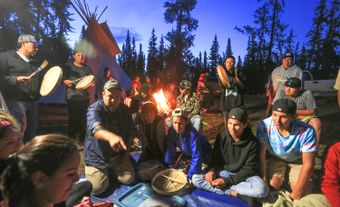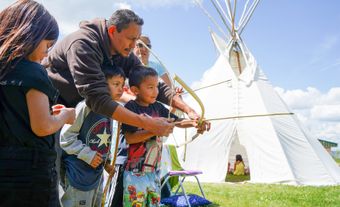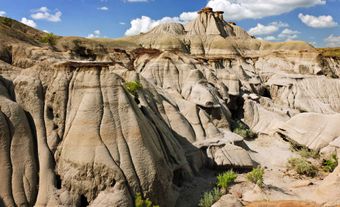Edmonton, Alberta, incorporated as a city in 1904, population 1,010,899 (2021 census), 933,088 (2016 census). Edmonton is the capital of Alberta, and is located on the North Saskatchewan River, near the geographical centre of the province. Commonly known as the "Gateway to the North," it is strategically situated on an economic divide between the highly-productive farmlands of central Alberta and a vast, resource-rich northern hinterland.
Indigenous Peoples
Edmonton's valley location, with its abundance of water, timber and wildlife, has attracted settlement for several thousand years. The archaeological record is incomplete, but in 1976 a large campsite containing stone tools from the Middle Prehistoric period (between 3000 and 500 BCE) was discovered on a high bluff overlooking the North Saskatchewan River, likely a place where bands of semi-nomadic Indigenous hunters and gatherers met regularly.
Edmonton is located on the traditional territory of the Siksikaitsitapi (Blackfoot Confederacy), Tsuut’ina, Stoney Nakoda, Cree and Métis peoples. The area is covered by Treaty 6, signed in 1876. (See also First Nations in Alberta; Reserves in Alberta.)
Settlement
Europeans began to enter the western plains in the 18th century. Settlement followed in 1795, when the Hudson’s Bay Company (HBC) and the North West Company built the first of a series of fortified trading posts near the present city of Fort Saskatchewan. After the two companies merged (1821), Fort Edmonton became the dominant centre of the western fur trade. The fort was reputedly named for Edmonton, now part of London, England, the birthplace of a deputy governor of the HBC. In 1830 the fort was rebuilt for the last time, on the present site of the Alberta Legislature Building. It gradually fell into disuse after the HBC surrendered its rights to Rupert’s Land (1870).
Development
Permanent settlement outside the fort did not begin until the 1870s, and even then was slow to develop. The construction of the Canadian Pacific Railway through Calgary (1883) did not help. A branch line came north in 1891, but it terminated at Strathcona, a community on the south bank of the North Saskatchewan River. Edmonton did not receive its own transcontinental connection (Canadian Northern Railway) until 1905. By then, it had also been selected to be the capital of the newly-created province of Alberta and was emerging as the natural service centre for a huge agricultural region into which settlers were flooding.
When Strathcona and Edmonton amalgamated in 1912, they entered a frantic boom period. Their combined population was over 50,000 and may have reached 75,000 soon after, only to drop to 50,000 during the First World War. For the next 25 years Edmonton's fortunes were closely linked with those of its agricultural resources. It grew in the good times, but stagnated or declined in the bad. By 1941 it was still a small city (93,800), ranking ninth in size in Canada. Its economy grew around regional wholesale trade, transportation and the processing of agricultural produce, notably meat packing. The only significant change in this period was Edmonton's new role as an air transport centre, both for trans-Canada flights and for bush flying into the North.
During the Second World War Edmonton began a sustained period of growth and assumed a distinctive new character: first as a strategic centre for northern military operations, including the construction of the Alaska Highway; and later as a servicing and processing centre for the petroleum industry. It has since become the major location of oil refining and the petrochemical industry in Canada, and by 1981 was Canada's fifth-largest city (by CMA). It lost that position to Calgary in 2001, and together the two cities have completely overshadowed Winnipeg, the historic commercial centre of the Prairie region.
With the expansion in production in the Athabasca oil sands since the early 2000s, Edmonton has again regained a fast rate of growth. For example, from 2006 to 2011, the city’s population increased 12.1 per cent, from 1,034,945 to 1,159,869.
Cityscape

In the process of growth, the city of 1941 was engulfed by new urban development. The main street of Strathcona was a rare exception and is protected today as part of the Old Strathcona conservation area. Edmonton's central area, by contrast, has been rebuilt continually since the 1950s. A few noteworthy buildings survive and several are restored to fashionable use, but they are dwarfed by the clustered towers that now dominate the Edmonton skyline. Only a few older buildings on open riverbank sites (the Legislature Building, Government House and the Macdonald Hotel) retain some prominence.
The river valley, which is Edmonton's outstanding natural feature, profoundly influenced its development. It is both a barrier, crossed by many bridges, and a magnificent amenity. High-rise apartments and elite residential areas compete along both banks for views of the river, and parks, golf courses and woodland trails stretch through the valley. Modern architecture, typified in the descending terraces of the Shaw Conference Centre, complements the valley setting. Downstream (northeast) to Fort Saskatchewan and beyond, the valley developed over the past 50 years into the largest industrial region in Alberta.
Fort Saskatchewan's industrial base makes it unusual; most of Edmonton's other satellites are bedroom communities for people working throughout the widespread metropolitan region. Metropolitan development came with postwar growth and led in 1950 to the establishment of the first regional planning organization in Canada. A city planning department emerged at the same time and was especially successful in ensuring that Edmonton's many new residential communities have been carefully designed.
Despite this history of careful planning, Edmonton’s recent rapid growth has not been without challenge: a 2013 study, for example, showed that 93 per cent of the growth that occurred between 2006 and 2011 took place in the suburbs, giving rise to the challenges associated with urban sprawl (such as the cost of roads and environmental stressors).
Also indicative of the city’s expansion is the measurable growth of its boundaries, which grew from 110 km2 in 1941 to 684.4 km2 in 2011. Unfortunately, this expansion took place on some of Alberta's richest farmland.

Edmonton is also home to the largest mall in North America, the West Edmonton Mall. At 5.3 million square feet, the mall is home to an indoor amusement park and wave pool, as well as the world’s largest parking lot.
Population
From the 1940s to the early 1980s, Edmonton was one of the fastest-growing cities in Canada. Until about 1961, natural increase was high, but migration was the chief factor in the city’s growth, as rural-urban migration from within Alberta and migration from Europe were both at a peak. Over the next decade, foreign migration dropped sharply, and natural increase became more important, a fact reflected at the time in the youthfulness of Edmonton’s population.
The pattern changed again in the 1970s, as birth rates fell and migration increased, though the majority of migrants now came from other Canadian provinces. That largely ceased in the 1980s, and Edmonton experienced its lowest growth of modern times. Nonetheless, over the 50-year period of 1941–91, Edmonton’s metropolitan population increased more than eight-fold. Since then, and especially since 1996, it has once again experienced a high rate of growth, with renewed migration both from elsewhere in Canada and from overseas.
According to the 2021 census, people citing English ethnicity make up Edmonton’s largest ethnic group, at 13.3 per cent of the city’s population, followed by Scottish (11.7 per cent) and German (11.6 per cent), Irish (10.8 per cent) and Ukrainian (9.3 per cent). The city’s visible minority population sits at 42.8 per cent, with South Asian, Chinese, Black and Filipino people making up the largest communities within this group. A further 5.8 per cent identify as Indigenous, which is a relatively large population when compared with cities in other provinces.
Economy and Labour Force
Edmonton's economy has always been driven by resource wealth. It is the major supply and service centre for a vast territory extending from central Alberta to the Arctic Ocean. Agriculture, energy production (coal, conventional oilfields, oil sands and natural gas), forestry and, most recently, diamond mining in the Northwest Territories and Nunavut provide the staples on which Edmonton's trade and service functions are based. Processing and manufacturing have increased in importance as well, especially as Edmonton seeks to diversify its economy.
Even with these developments, Edmonton's industrial base remains heavily dependent on natural resources (e.g., petroleum refining, petrochemicals, plastics, fertilizer) and the needs of resource-based industries (e.g., manufacturing of pipe and heavy equipment, metals fabrication), though Edmonton firms are prominent in a variety of fields, including construction, engineering services, electricity generation, banking and retailing.
In terms of employment, Edmonton's greatest growth since 1951 has been in the tertiary or service sector. It is particularly notable as a centre for public administration (federal and provincial) and as home of the University of Alberta. There is an array of high-tech industries, mainly in biotechnology and information technology, which have been vital to the restructuring of Edmonton's economy. In the mid-1990s, military services for Western Canada were consolidated at a new "superbase" called the 3rd Canadian Division Support Base Edmonton (or locally, the Edmonton Garrison).
Transportation
Since the 1830s Edmonton has been a major hub in the transportation network of Western Canada. As a modern rail centre, it occupies a key position in the transcontinental freight system of the Canadian National rail system, and has strong links to the Canadian Pacific Railway system and to VIA Rail. As a road transport centre, it has one of the most important locations in Western Canada, at the intersection of the Yellowhead Highway and Alberta's Highway 2 (renamed the Queen Elizabeth II Highway in 2005), which leads south to Calgary and the United States, and north to the Alaska Highway. Edmonton also dominates the transportation system for petroleum products of all kinds, a pattern that arose from its proximity to the Leduc, Redwater and Pembina oil fields. In the 1940s and 1950s, these were the most important oil fields in Alberta.
Leduc is also the location of the Edmonton International Airport, opened in 1957. It caters to main-line service to Canadian, American, Latin American and European cities. The original airport, located near the city centre, opened in 1927 and closed in 2013. It was significant in establishing Edmonton as a gateway to the north, but its importance declined after the international airport opened.
Edmonton was the first medium-sized Canadian city to construct a Light Rail Transit (LRT) system (1978). The original line was extended several times. The city's long-term plan includes eventually adding more lines that branch out in each direction from the downtown core.
For now, however, most people travel around the city by private automobile and a freeway network is gradually taking shape. The final leg of Anthony Henday Drive, a multi-lane freeway commonly known as the Edmonton Ring Road, opened in 2016. The freeway encircles Edmonton on its outskirts and connects the Trans-Canada Highway with the Queen Elizabeth II Highway.
Communications
Edmonton has several newspapers, including the Edmonton Journal and the Edmonton Sun. The city also has a small but diverse publishing industry including several book publishers and various community and trade publications.
Government and Politics

Until 1984 Edmonton had a council-commission board form of municipal government, with each council serving a three-year term. The commission board has now been replaced by an executive committee which has a rotating membership. The council comprises a mayor elected at large and 12 councillors representing one ward each.
Candidates normally stand as independents, though party slates have occasionally achieved some success. The most notable, known as URGE (Urban Reform Group of Edmonton), originated in the citizen protest movements of the 1970s. URGE is now defunct, but it was indicative of a political pattern in which Edmonton gives the Liberal and New Democrat parties their main support in Alberta. A number of municipal politicians in Edmonton have gone on to serve in the provincial legislature or House of Commons, such as Laurence Decore, Brian Mason, Lance White and Ethel Sylvia Wilson.
Edmonton has a long history of municipal ownership of utilities, going back to the 1890s. This changed radically in the 1990s, a time when government services were being privatized everywhere. First the telephone system was sold to Alberta Government Telephones (now Telus), and then the power and water utilities became EPCOR, a private company in which the city of Edmonton is sole shareholder. EPCOR now sells its services well beyond Edmonton.
Throughout its history Edmonton has generally been able to annex territory to meet its growth needs, though this has often brought it into conflict with suburban municipalities. A Capital Region Board was created in 2008 to coordinate planning and transportation policy between Edmonton and 24 other municipalities in the area.
Cultural Life
The Edmonton Symphony Orchestra, the Edmonton Opera and the Citadel Theatre are three of the largest performing arts organizations in Canada. Many notable artists and performers hail from Edmonton, including authors Rudy Wiebe and Lynn Coady, hip hop artist Cadence Weapon, electronic group Shout Out Out Out Out, country musician Corb Lund and visual artist Aaron Paquette.
Many different ethnic groups also contribute a lively folk culture, and dozens of artistic and ethnic festivals are hosted in Edmonton every year, giving it the nickname “Canada’s Festival City.” Among them are the Edmonton International Fringe Theatre Festival, the largest and oldest fringe festival in Canada, the Edmonton Folk Music Festival, the Edmonton International Jazz Festival and the Works Art & Design Festival. The 10-day K-Days exhibition traces its origins back to 1879 when it began as an agricultural fair.
The chief facilities for artistic performances and displays are the Northern Alberta Jubilee Auditorium, the Art Gallery of Alberta, the Stanley A. Milner Library, the Citadel Theatre, Francis Winspear Centre for Music and the Timms Centre for the Arts of the University of Alberta, one of Canada's leading universities. Other major educational institutions are the Northern Alberta Institute of Technology and MacEwan University. These are complemented by a range of popular facilities, including the Royal Alberta Museum, the Muttart Conservatory, the John Janzen Nature Centre, Fort Edmonton Park and the city's science centre, Telus World of Science.
In sports, Edmonton professional franchises include the Edmonton Eskimos of the CFL, the Edmonton Oilers of the NHL and the Edmonton Rush of the National Lacrosse League.
The main facilities are: Commonwealth Stadium (built for the 1978 Commonwealth Games and expanded to 60,000 seats for the World University Games in 1983), home of the Eskimos; the Kinsmen Sports Centre (also built for the Commonwealth Games); Rexall Place, home of the Oilers; the Edmonton Northlands horse racing track and exhibition space; and Telus Field. In recent years the city has hosted a variety of international sporting events (track and field, swimming, rugby, soccer, baseball and figure skating) and it has become a regular stop on the triathlon and marathon circuits. In addition, the Canadian Finals Rodeo is held in Edmonton every year.

 Share on Facebook
Share on Facebook Share on X
Share on X Share by Email
Share by Email Share on Google Classroom
Share on Google Classroom







